Picto Diary - 07 to 11 April 2025 - Madrid

Above: Restaurant Nederland 1814. Valencia, Spain. 07 April 2025
Pre departure (Madrid) relaxation. AM jolt. Fountain gurgles.

Above: Restaurante Meson San Juan Plaza Mayor, Cuenca, Spain. 07 April 2025.
Halfway lunch spot between Valencia and Madrid. Doesn't look like much, but like Italy, it's hard to find a bad meal in Spain.

Above: Ciudad Encantada, Spain. 07 April 2025
On a lark, we asked our driver to take us to this place, 20 miles from Cuenca. Weather and the waters of the nearby Jucar River have formed rocks into distinctive and memorable shapes. Full disclosure. We didn't actually see the spot. It was located three kilometers from the parking lot. Due in Madrid in two hours, we neither had the time nor the inclination for the long walk

Above: Madrid, Spain. 07 April 2025.
Rendus.

Above: Uniqlo Madrid. 08 April 2025.
TIMDT does Uniqlo Madrid. It is, of course, important to set priorities when travelling in Europe. The Royal Palace of Madrid, The Prado Museum, and top-rated flamenco dancing must get in line behind shopping. I'm reminded of the time ten or so years ago when I was following TIMDT and her friends around Italy on my Ducati ST-4 motorcycle. I caught up with the girls in Florence and spent the night with TIMDT. I joined the girls at breakfast the next morning. Our friend Pat asked me, "Steve what are you going to do this AM?" Puzzled, I said "I thought I would accompany you guys to see the sights." Pat said, "well, why don't you just go alone to see the Duomo, the David, and Ponte Vecchio?" "Why," I replied. "What are you guys going to do?" Pat said, "we're going to Frette, Christophel and Tods."
This was my first exposure to the Uniqlo marque... a Japanese brand, relatively inexpensive and trendy. It seems Uniqlo has captured the chic cachet that Target once had. In the image, TIMDT is wearing a light, Uniqlo jacket that she purchased at Uniqlo Barcelona five days ago. She is deciding whether or not to buy another one of a different color.

Above: Tuk Tuk tourists. Madrid, Spain. 08 April 2025.
Left to right: Bishop, Hoops, TIMDT, Bronx Girl.
The Tuk Tuk tour was a pretty good way to maneuver the nooks and crannies and narrow streets of Madrid. Mostly, I'll remember our driver/guide, who's amplified voice came through a small speaker attached to the partition in front of the girls. A thirty-five something, with a bandana around his forehead, he was very knowledgeable. His accented, but understandable, English was endowed with a colloquial deftness not always found in English as a second language tour guides. He was responsive to questions outside of the sightseeing agenda we were following. For example, "what is an average middle-class salary?" Guide: "Around Euros 30K per annum." What is the cost of a rental of a two-bedroom house/flat fifteen miles from town?" Guide: "Euros 1500." Guide: "You need two incomes to afford to live in a two-bedroom place. I live in such a place on one income, but I have an inheritance to help me out."

Above: El Senador Restaurant. Madrid, Spain. 08 April 2025.
Pig. It's what's for dinner.
PS. Pig, not pork. Meaning, in Spain, there is no different name for an animal to be consumed and an animal on the hoof. El Senador was restaurant specializing in "pig."

Above: Corte Ingles department store, Madrid, Spain. 09 April 2025.
Roof top lunch. And only Euros 8 for two scoops of lemon sorbet! Image looks in the direction of the Royal Palace, at the image border of the NE quartile image segment. The large structure in the center of the NE image quartile is the Opera House. Our hotel, in the same area, but not discernable in the image, was Palacio de los Duques.

Above: Royal Palace, Madrid, Spain. 10 April 2025.
Ceiling. Two female figures reaching out to one another symbolize the symbiotic relationship between the Spanish Church and State. That was then.
In today's Spain, and in most of the rest of Western Europe, the influence of the Church is negligible. The monarchy, once partner to the Church, has morphed into a national symbol without political power. The vacuum left by the impotent monarchy and abnegation of Church influence has been filled by the "principles" of the new Democratic Socialist state as administered by the European Union.
The Democratic Socialist state introduces individual freedom, self-expression and a globalist world view as cultural guidelines substituting for the emphasis on family, community, religious devotion, national patriotism and virtue put forward by the Church.
Today European countries are challenged by slow economic growth, growing regulations and diminishing freedoms, such as curtailments on free speech. And while large scale immigration from Muslim countries has stemmed European population decline it has also resulted in rising sectarian tension due to resistance by immigrants to assimilate into the Democratic Socialist "value neutral, do your own thing" cultural model.
Of European nations, Russia alone has resisted following the path of Democratic Socialism and has opted for a cultural and economic model where the Church plays a strong role, co-equal with the state, as was the practice in former times throughout Europe. Russia's "state" is not a monarchy. Let's call it democratic authoritarianism. As contradictory as that sounds, Russian presidents are elected but, admittedly, the hurdles to win over the party in power are high. Still, the current Russian state, unlike the Democratic Socialist state in Europe, values The Church and actively encourages its acceptance among the Russian population.
President Vladimir Putin, in his effort to revive Russia from the horrors of Bolshevism, where the Soviets executed over ten million Christians, has analogized the balance between Church and State to a double helix DNA strand, where each strand is essential in building a healthy national culture. Unlike the sterile, totalitarian culture of Russia under the Bolsheviks, where the Church was marginalized, today's Russian state believes in the role of the Church even to the point of subsidizing its recovery from the Communist days. Russia is now returning to its roots as a Christian, conservative society were religion, patriotism and family are touch stones.
So, now we have two economic and cultural models in Europe, one incorporating Christianity as an essential partner to the state and the other marginalizing Christianity. Both models are challenged by growing Muslim populations. One, Europe, welcomes Muslims as immigrants. The other, Russia, uses strong arm tactics to keeps its indigenous Muslim population under control. While the Church is dead in Europe, it is put forward as a vital component to achieving cultural success in Russia. The mural on the ceiling of the Royal Palace in Madrid still has some relevancy today, just not in Spain and most of Europe.
Addendum:
Loved all of these photos. Alas, the Cleveland Orchestra never toured in Spain, so it was fun to travel the”virtually” through your cruise!!
Enjoy!!
Music in the Mountains of Wisconsin!!!
More beauty and insight. “You have chosen wisely” Holy Grail! Cool. 😎
Tony,
Park City, UT
Dear Steve and Margaret,
We love seeing these photos or your amazing trip and I want you to know that our son Bill is flying back right now from a similar trip in Europe. Ken is jealous because I don’t feel as if I can travel that far and that long! Europe, where there are no billboards, where they have preserved their buildings and all things beautiful. We still have a great country in spite of recent turmoil. We could learn a lot from Europe though!
XO,
Kate and Ken
Salt Lake City, UT
Steve! So impressive. I served my mission in Spain, started in Andalucia. So long ago. Franco was still in charge. We had to be very chary about even using the name of the Church. Religious freedom was new in the country and not well publicized. We were officially to represent ourselves as “Non-Catholic Association Number 72.” I had to spring the elders out of jail more than once!
I hope Margaret is feeling better!
Apple Store,
Salt Lake City, UT